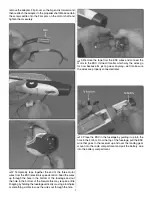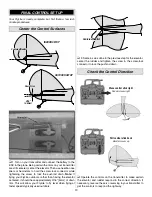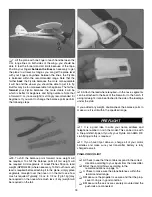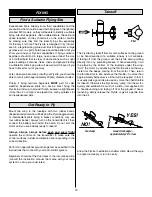
18
❏
7. Lift the plane with one fi nger of each hand between the
C.G. range lines on both sides of the wing—you should be
able to feel the forward and aft limits because of the tape.
Position your fi ngers
between the lines
as necessary to get
the plane to sit level. As long as you can get the plane level
with your fi ngers anywhere between the lines, the FlyLite
is balanced within the recommended range. Note that the
farther
back
the FlyLite balances the more maneuverable
it will be and the slower you should be able to get it to fl y.
But this may be too maneuverable for beginners. The farther
forward
your FlyLite balances, the more stable it will be
which is better for beginners and fl ying outdoors. Note that
a forward C.G. (nose weight) is strongly recommended for
beginners. If you want to change the balance point perform
the following steps.
❏
8. To shift the balance point forward, nose weight will
be required. To shift the balance point aft tail weight will
be required. Add segments of Great Planes Stick-on lead
weight (GPMQ4485) where necessary. To fi nd out how much
lead is required before attaching it to the plane, simply place
segments of weight over the nose or on the tail to see how
much is required. Typically, 1/4 oz. to 1/2 oz. [7g to 14g] may
be required on the nose while much less (if any) weight will
be required on the tail.
❏
9. Attach the lead where required—in the nose, segments
can be attached to the back of the fi rewall or to the hatch. If
using tail weight, it can be attached to the side of the fuselage
under the stab.
If you added any weight, double-check the balance point to
make sure it is still within the specifi ed range.
PREFLIGHT
❏
1. It is a good idea to write your name, address and
telephone number on or in the model. This can be done with
a fi ne-point felt-tip pen. If you fl y your FlyLite at an AMA R/C
club fl ying site this is required.
❏
2. If you haven’t yet done so, charge all of your motor
batteries and make sure your transmitter battery is fully
charged as well.
FINAL CHECK LIST:
❏
A. Check to see that the controls respond in the correct
direction according to your inputs from the transmitter.
❏
B. Set the control throws according to the
recommendations on page 14.
❏
C. Check to make sure the plane balances within the
recommended range.
❏
D. Make sure the propeller is secure and that the prop-
saver O-ring is in good condition.
❏
E. Make sure the servos are securely mounted and the
pushrods are connected.







































